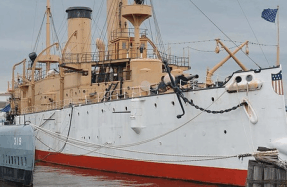

A supermarket at Chertsey in Surrey summed up the public feeling with a sign in its window stating ‘we do not sell Argentina corn beef’. Within days of the assault at Port Stanley, a Royal Navy force of warships was assembled at Portsmouth and Plymouth ready to sail 8,000-miles to the South Atlantic. The assault on the Falklands was viewed by most people as a surprise action, but Prime Minister, Margaret Thatcher, and a small number of her ministers inside Downing Street had been aware of Argentina’s intent – but did not believe that the junta would take military action. The UK’s intelligence services had been monitoring the jingoistic claims in Buenos Aires, but failed to identify Argentina’s plans. Inside the Foreign Office, ministers reinforced the belief that the military dictator would not go to war. The intelligence or ‘mood music’ coming out of Argentina had been ‘noted’ in London but not acted upon. There had been plenty of warnings that the junta was preparing for conflict, but politicians had been caught off-guard.

Since being appointed President in 1981, Galtieri, a former Army General, had been exploring opportunities to recover the islands. He was at the centre of a ‘dirty war’ in which people who opposed the regime went missing, were tortured and murdered. The new President faced an economy that was in melt-down, as a severe recession gripped the country. Interest rates and unemployment soared, there was rioting in the streets and food prices were at an all-time high. He needed to pull the country together and find a way to save his political future. Previously, there had been a period of diplomatic stability in which Argentina was given trade access to the Falklands, but since seizing power the junta was desperate to settle growing domestic unrest. Capturing the Falklands would boost national pride and the announcement by London in 1981 of major cuts to the Royal Navy, including the ice patrol ship HMS Endurance, based in the South Atlantic, sent a signal to Argentina that the UK was not giving any priority to security in the region. Now was the time to strike. For decades, ministers in London had failed to resolve the Falklands issue and instead had given Buenos Aires hope that they could secure sovereignty through negotiation. For Downing street their political game of posturing and promises had failed – now the situation was about to get very ugly.


On 19th March 1982, a group of Argentine scrap metal workers landed ashore at Leith Harbour in South Georgia, an island which is part of the British Falklands had called at South Georgia to assess the work. Then in 1982, the scrap workers had arrived aboard the 5,000-tonne transport ship ARA they stepped ashore but instead of removing the whaling station they raised the Argentine flag. At the time, a British Antarctic Survey (BAS) team was the only British presence at Leith and the BAS leader, Tretor Edwards, informed London about the Argentine presence. The Foreign Office requested that Edwards pass a message to the commander of the Argentine ship, Captain Briatore, directing him to remove the flag, stop any activity and put to sea. The Governor of the Falkland Islands, Rex Hunt, who was based in Port Stanley had also been informed of events in South Georgia. After consulting London, Hunt ordered the ice patrol ship HMS which had just arrived in the Falklands, to head tor South Georgia with a party of 22 Royal Marine Commandos embarked. It was a distance of 800 miles and would take several days, by which time Downing Street hoped the unwelcome guests would have packed their bags and gone. The political pressure in London was now rising, but still ministers tailed to grasp the political aspirations of the military junta in Buenos Aires.






